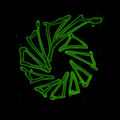Template:Selected anniversaries/October 3: Difference between revisions
No edit summary |
No edit summary |
||
| Line 2: | Line 2: | ||
||1533: Michael Stifel predicted that on this date a chariot would touch down on a nearby hilltop and conduct him and his followers to heaven. Followers of the mathematical mystic quit their jobs, but as the day approached they became skeptical. Stifel convinced the local constabulary to lock him in jail on the appointed date where he would be safe from his ruined, irate parishioners. Pic. | ||1533: Michael Stifel predicted that on this date a chariot would touch down on a nearby hilltop and conduct him and his followers to heaven. Followers of the mathematical mystic quit their jobs, but as the day approached they became skeptical. Stifel convinced the local constabulary to lock him in jail on the appointed date where he would be safe from his ruined, irate parishioners. Pic. | ||
||1704: Physician Jean-Baptiste Denys dies. He performed the first fully documented human blood transfusion, a xenotransfusion. He was the personal physician to King Louis XIV. Pic | ||1704: Physician Jean-Baptiste Denys dies. He performed the first fully documented human blood transfusion, a xenotransfusion. He was the personal physician to King Louis XIV. No DOB. Pic. | ||
||1716: Giovanni Battista Beccaria born ... physicist and academic. Pic search: https://www.google.com/search?q=giovanni+battista+beccaria | ||1716: Giovanni Battista Beccaria born ... physicist and academic. Pic search: https://www.google.com/search?q=giovanni+battista+beccaria | ||
| Line 8: | Line 8: | ||
||1830: George Brayton born ... mechanical engineer who lived with his family in Boston and who is noted for introducing the constant pressure engine that is the basis for the gas turbine, and which is now referred to as the Brayton cycle. Pic. | ||1830: George Brayton born ... mechanical engineer who lived with his family in Boston and who is noted for introducing the constant pressure engine that is the basis for the gas turbine, and which is now referred to as the Brayton cycle. Pic. | ||
||1842: Arthur Cayley admitted to fellowship at Trinity College, Cambridge, at age 21, younger than any other fellow at the College. | File:Arthur Cayley.jpg|link=Arthur Cayley (nonfiction)|1842: Mathematician [[Arthur Cayley (nonfiction)|Arthur Cayley]] admitted to fellowship at Trinity College, Cambridge, at age 21, younger than any other fellow at the College. | ||
||1846: Platon Poretsky born ... astronomer, mathematician, and logician. Pic. Different DOB at On This Day in Math. | ||1846: Platon Poretsky born ... astronomer, mathematician, and logician. Pic. Different DOB at On This Day in Math. | ||
Revision as of 10:08, 7 March 2019
1842: Mathematician Arthur Cayley admitted to fellowship at Trinity College, Cambridge, at age 21, younger than any other fellow at the College.
1881: Mathematician and religious leader Orson Pratt dies. As part of his system of Mormon theology, Pratt embraced the philosophical doctrine of hylozoism.
1882: Canterbury scrying engine reprogrammed to detect and expose crimes against mathematical constants.
1891: Mathematician Édouard Lucas dies. He studied the Fibonacci sequence; the related Lucas sequences and Lucas numbers are named after him.
1930: Mathematician Robin Farquharson born. He will write an influential analysis of voting systems in his doctoral thesis, later published as Theory of Voting.
2006: Mathematician and physicist John Crank dies. He worked on the numerical solution of partial differential equations; his work with Phyllis Nicolson on the heat equation resulted in the Crank–Nicolson method.
2012: Physicist and astrophysicist Robert F. Christy dies. He is generally credited with the insight that a solid sub-critical mass of plutonium could be explosively compressed into supercriticality, a great simplification of earlier concepts of implosion requiring hollow shells.
2018: Green Spiral voted Picture of the Day by the citizens of New Minneapolis, Canada.







